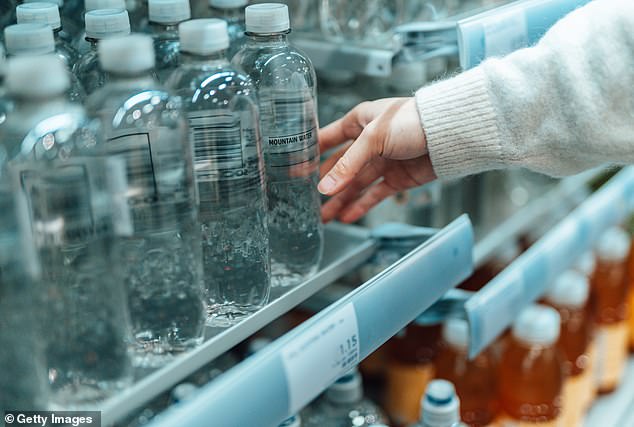Which nanoplastics are in YOUR water bottle and how exactly do they get there? A shock study shows that there are an average of 240,000 pieces
There is probably one on your desk, kitchen counter or bedside table.
But plastic water bottles are traps for nanoplastics – an umbrella term for the toxic particles linked to cancer, fertility problems and birth defects.
Research this week found that the average one-litre bottle contains 240,000 units. For comparison, this figure is only 5.5 per liter of tap water.
Invisible to the human eye, nanoplastics are between one and 1,000 nanometers in size, with 1,000 nanometers equal to one hundredth of a millimeter.
They occur when plastics break down into smaller and smaller pieces. They are so small and light that they are carried in the air around us and have been found in water, food and everyday products.
MAILONLINE PHONE AND APP READERS CAN INTERACT WITH THE BOTTLE GRAPH BELOW BY PRESSING THE IMAGES
Because they are so small, they can pass through the intestines and lungs, directly into the bloodstream and to organs including the heart and brain.
They can even pass from the placenta into the bodies of unborn babies.
Researchers from Columbia University, who conducted the latest research, painstakingly identified and counted these tiny particles in bottled water, detecting seven common plastics.
Results, published in the journal Proceedings of the National Academy of Sciencesrevealed concentrations are up to 100 times greater than previously thought.
Polyethylene terephthalate (PET) and polyethylene (PE), plastics used to make bottles, were among the most common nanoplastics identified.
They are thought to break off and enter the water when bottles are squeezed or the lid is opened and closed repeatedly.
They can also enter water if a bottle is exposed to heat, for example in a warm room, in the car on a hot day or outside in the sun.
However, most nanoplastics end up in bottled water through the environment or the manufacturing process, with the scientists noting that plastic pollution has been detected ‘at every step from source to bottle’.
Polyvinyl chloride (PVC) was one of the most common and toxic nanoplastics found in groundwater and bottled water.
It is believed that this nanoplastic enters water sources as a result of plastic production, with 30 million tons dumped into water or land every year.
In addition, many products made with plastic, such as synthetic clothing, some tea bags and fishing nets, emit particles during use.
Drinking water from a bottle could mean contaminating your body with tiny bits of plastic, which scientists fear could build up in your vital organs with unknown health consequences.

According to the research, other variations, such as polypropylene, enter the product during the bottling process
Instead of breaking down into harmless substances, plastic materials retain their chemical composition as they divide into smaller and smaller particles.
As a result, nanoplastics such as PVC end up in water sources.
According to the research, other variations, such as polypropylene (PP), enter the product during the bottling process.
PP is widely used in equipment needed for manufacturing and as an aid in solidification – a process necessary to remove hazardous materials from water.
Scientists also discovered polystyrene (PS) in the bottled water they studied.
PS is the material used in water purification, which removes harmful contaminants and replaces them with minerals – a process known as ion exchange.
Polyamide (PA), a type of nylon, was also found in bottled water.
Researchers believe that this, ironically, comes from plastic filters that water is passed through in an attempt to purify it before bottling.
PA is the most popular material used to make these filters.
However, these nanoplastics make up only 10 percent of all nanoplastics discovered by the scientists, who admitted they have no idea what the other 90 percent are.
Nanoplastics have been worrying scientists for decades and have been found everywhere on Earth, from Arctic ice to soil and from drinking water to food.
Researchers are afraid because the smaller things are, the easier they can get into us.
Previous studies have suggested that the average person ingests around five grams of plastic per week – the equivalent of a credit card.
However, experts have warned it could be much more as not all foods have been analyzed to check their plastic content.
It is also thought that people inhale up to 7,000 microplastics a day, raising concerns that they could be considered a health threat alongside asbestos or tobacco.
Plastic bottles in particular have come under scrutiny for their contribution to nanoplastic intake, with experts even warning that pregnant women should avoid drinking from them after a study found they can enter the organs of fetuses.
Nanoplastics do not break down in the body, so they can potentially cause inflammation and stress in the cells.
While research into their effect on human health is still in its infancy, animal studies have suggested that the particles can cause inflammation and organ damage and affect reproduction, gut bacteria and metabolism.
Studies in humans have suggested that nanoplastics, especially PVC, increase the risk of lung cancer, while research in mice has found a link between PS and ovarian cancer.
